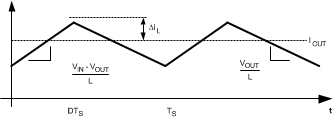SNVSB35C May 2018 – November 2024 LM26420-Q1
PRODUCTION DATA
- 1
- 1 Features
- 2 Applications
- 3 Description
- 4 Pin Configuration and Functions
- 5 Specifications
- 6 Detailed Description
-
7 Application and Implementation
- 7.1 Application Information
- 7.2 Typical Applications
- 7.3 Power Supply Recommendations
- 7.4 Layout
- 8 Device and Documentation Support
- 9 Revision History
- 10Mechanical, Packaging, and Orderable Information
7.2.1.2.2 Inductor Selection
The duty cycle (D) can be approximated as the ratio of output voltage (VOUT) to input voltage (VIN):

The voltage drop across the internal NMOS (SW_BOT) and PMOS (SW_TOP) must be included to calculate a more accurate duty cycle. Calculate D by using the following formulas:

VSW_TOP and VSW_BOT can be approximated by:
The inductor value determines the output ripple voltage. Smaller inductor values decrease the size of the inductor, but increase the output ripple voltage. An increase in the inductor value decreases the output ripple current.
Make sure that the minimum current limit (2.4 A) is not exceeded, so the peak current in the inductor must be calculated. The peak current (ILPK) in the inductor is calculated by:
 Figure 7-8 Inductor Current
Figure 7-8 Inductor Current
In general,
If ΔiL = 20% of 2 A, the peak current in the inductor is 2.4 A. The minimum specified current limit over all operating conditions is 2.4 A. Either reduce ΔiL, or make the engineering judgment that zero margin is safe enough. The typical current limit is 3.3 A.
The LM26420-Q1 operates at frequencies allowing the use of ceramic output capacitors without compromising transient response. Ceramic capacitors allow higher inductor ripple without significantly increasing output ripple voltage. See the Section 7.2.1.2.4 section for more details on calculating output voltage ripple. Now that the ripple current is determined, the inductance is calculated by:

where

When selecting an inductor, make sure that the inductor is capable of supporting the peak output current without saturating. Inductor saturation results in a sudden reduction in inductance and prevents the regulator from operating correctly. The peak current of the inductor is used to specify the maximum output current of the inductor and saturation is not a concern due to the exceptionally small delay of the internal current limit signal. Ferrite based inductors are preferred to minimize core losses when operating with the frequencies used by the LM26420-Q1. This presents little restriction because the variety of ferrite-based inductors is huge. Lastly, inductors with lower series resistance (RDCR) provides better operating efficiency. For recommended inductors, see Table 7-2.